Man has always sought peace and safe environments suitable for workflow, productivity, progress and development, while sustaining a happy life free from violence. In a world riddled with crises and challenges, measuring peace around the world and monitoring associated impacts and outcomes over individuals and states have come to prominence.
Institute for Economics and Peace
The Institute for Economics and Peace (IEP) in Sydney, Australia, is one of the major centers that measures peace metrics around the world. It was founded in 2007 and is headquartered in several cities: New York, Mexico City, Brussels, and the Hague. IEP has developed close partnerships with several distinguished and most influential scientific research centers and follows partnership regulations with the United Nations Development Program, UNISEF, World Bank Group (WBG), and NATO.
IEP is marked as an autonomous and non-profit institute, that is objective and unbiased to any entity or state, making it trustworthy to governments and international entities. It has also become a main accredited reference for scientific entities, research centers, and those interested in measuring global peace. IEP measures peace in 163 states, which comprise around 99.7% of the world’s population. It publishes an annual index known as the Global Peace Index (GPI), ranking states according to criteria that form the GPI, in consultation with an international team of experts at research centers and institutes and in collaboration with the Department of Peace and Conflict Studies at the University of Sydney. IEP issued its first publication in May 2007, and still publishes the GPI regularly. The 2021 fifteenth edition of the GPI has been recently issued.
This report investigates four pillars reported by the 2021 GPI issued by IEP. The 1st pillar tackles the definition of the GPI and its three domains and the indicators related to each one. The 2nd pillar covers the results of the GPI and highlights the progress of global peacemaking and the consequences of such results. It presents the state of IMCTC among these consequences. The 3rd pillar examines the economic impact of violent acts and how this impact varies in IMCTC countries. The 4th pillar addresses the Positive Peace and associated bases.
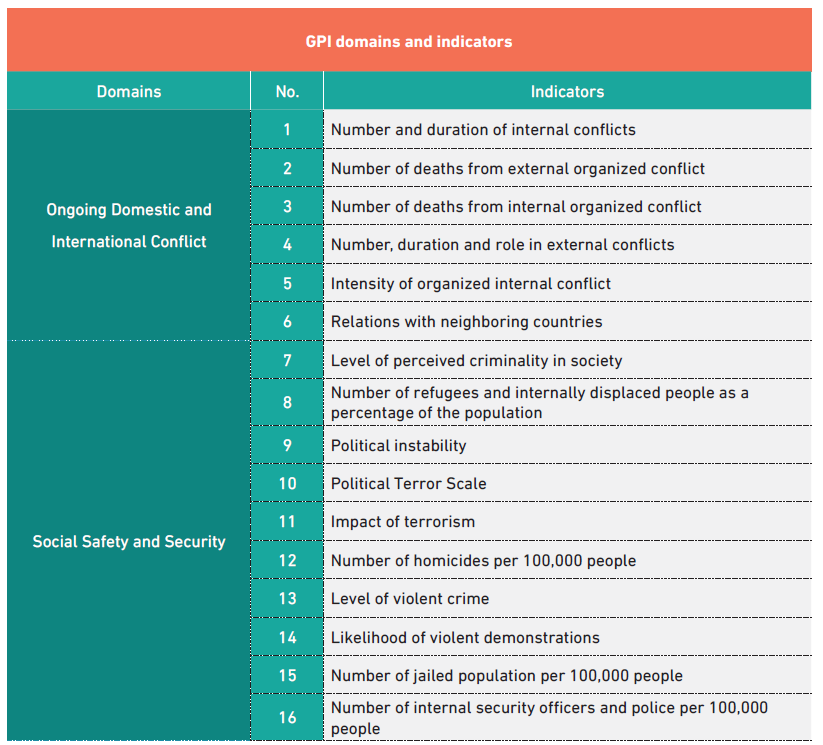
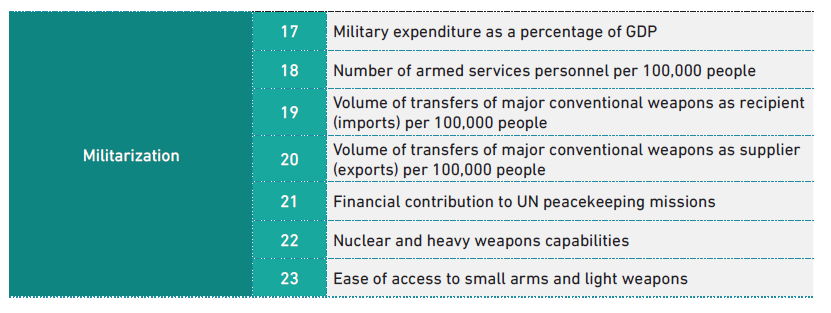 GPI Domains
GPI Domains GPI measures global peace across three main domains, each comprising a number of indicators:
- The first domain: Ongoing Domestic and International Conflict, which includes six indicators capturing the state, severity, and duration of conflicts drawing on the legitimacy of governments, sectarian strife, established peace, potential external conflicts and their impact on the state to be evaluated.
- The second domain: Societal Safety and Security, which includes ten indicators regarding development, rule of law, equality in different societies, challenges posed by terrorism, instability, and the violence faced by the state to be evaluated, which in turn has an impact on social safety and security.
- The third domain: Militarization, which includes seven indicators that measure the extent of military intervention in state authority, oppression of society, military expenditures, arms imports, and destructive capabilities.
Accordingly, there is a total of 23 indicators within the three main domains.
Some of the aforementioned indicators—the ones including percentages and numbers—are evidently quantitative, such as the ratio of military expenditure to the GDP. Others are qualitative, requiring special evaluation using certain data, such as the first domain indicators of the intensity of internal conflict and relations with neighboring countries.
All indicators are observed to address measuring peace inversely, i.e., measuring all that threatens peace rather than what reinforces it. Thus, the increase in the number representing each indicator means the deterioration of the state of peace in the state under evaluation according to the relevant indicator, as well as the receded international ranking among other states.
GPI Results
Based on previous domains and indicators, 2021 GPI results can be presented as follows:
- Overall results;
- Results of each of the three GPI domains;
- Results in select countries, including the first and last ranking countries on the GPI and the permanent Member States of the UN Security Council;
- The impact of COVID-19 pandemic on peacemaking;
- The order of IMCTC Member States in the 2021 GPI.
Overall Results
GPI overall results indicate the following:
- A slight decline in the global peacefulness, as recorded in the current 2021 GPI edition, by 0.07% compared to 2020 GPI edition, in 73 states, and an improvement in the peacefulness of 87 states;
- A decline in the global peacefulness by 2% since the first issuance of GPI over fifteen years, and a decline in the peacefulness according to 15 of the 23 indicators of GPI over the period of 2008–2021;
- A decline in peacefulness across 6 of the 9 regions: Sub-Saharan African, Russia and Eurasia, South and Central America, the Caribbean, Asia-Pacific, and North America, which recorded the highest decline due to increased crime, civil unrest, and political instability;
- An improvement in peacefulness in 3 of the 9 regions: Europe, South Asia, MENA and North Africa, which recorded the highest improvement, but yet remained the least ranking globally.
GPI Methodology
The GPI results of the period 2008–2021, according to the three GPI domains, indicate the following:
- The first domain, Ongoing Domestic and International Conflict, is the most deteriorating by 6.2%, including five indicators of a total six. The number of deaths from internal organized conflict indicator is the only one that witnessed an improvement in this domain.
- The second domain, Social Safety and Security, showed less deterioration than the first by 2.5%, including nine indicators of a total eleven. The impact of terrorism indicator is considered the most deteriorating, specifically in 90 out of 163 assessed states.
- The third domain, Militarization, is the only one to show an improvement by 4.2%, including 111 states, while only 50 states experienced deterioration. All indicators of this domain showed improvement, except for the weapons imports indicator that showed obvious deterioration.
Selected Countries
The selected countries are the ones recording the highest and lowest levels on the GPI and the big powers that are permanent members of the UN Security Council. Results indicate that:
- The ten countries at the top of the GPI are ranked in the following order: Iceland, Denmark, Portugal, Slovenia, Austria, Switzerland, Ireland, Czech Republic, Finland, and Norway. Iceland remained on top of the GPI since 2008;
- The ten countries at the bottom of the GPI are ranked in the following order: Afghanistan, Yemen, Syria, South Sudan, Iraq, Somalia, Democratic Republic of Congo, Libya, Central Africa, and Russia. Afghanistan has fallen at the bottom of the past four GPI editions;
- The big powers, which are the five permanent Member States of the UN Security Council, are ranked on the GPI in the following order: UK (33), France (55), China (100), USA (122), and Russia (154).
Impact of COVID-19 Pandemic on Peace
The 2021 GPI results have shown the impact of COVID-19 pandemic on global peace as follows:
- The outbreak of COVID-19 pandemic in 2020 resulted in acute economic crises, which led to protests and demonstrations in many countries all over the world. 5,000 violent events were recorded between January 2020 and April 2021.
- Given the unclear vision so far regarding ending the pandemic in the near future, the GPI concludes that the economic and political unrest may continue, and, thus, warns against triggering demonstrations and protests that might lead to violent acts probably affecting the global peacefulness.
IMCTC Member Countries
The GPI classified the IMCTC countries according to their peacefulness into five groupings as follows:
-
1st grouping: states ranking the first fourteen on the GPI, marked by a dark green color.
-
2nd grouping: states ranking from 15 to 58 on the GPI, marked by a light green color.
-
3rd grouping: states ranking from 59 to 123 on the GPI, marked by a yellow color.
-
4th grouping: states ranking from 124 to 150 on the GPI, marked by an orange color.
-
5th grouping: states ranking from 151 to 163 on the GPI, marked by a red color.
The following table demonstrates the ranking order of the IMCTC countries on the 2021 GPI according to the aforementioned marking colors as follows:
- 1st grouping does not include any IMCTC countries.
- 2nd grouping includes 7 IMCTC countries.
- 3rd grouping includes 15 IMCTC countries.
- 4th grouping includes 11 IMCTC countries.
- 5th grouping includes 5 IMCTC countries.
- 3 IMCTC countries were not included in the 2021 GPI rankings: Brunei Darussalam, Maldives Republic, and the Union of the Comoros.
Economic Impact
The 2021 GPI introduces a study of the economic impact of violence across the aforementioned GPI indicators, including:
- The economic foundations of the study;
- The overall results of the economic impact;
- The results of the economic impact in IMCTC countries.
Economic Foundations
The economic foundations are the main components the study was based on and the conclusions as follows:
- Direct costs are the direct expenditures resulting from acts of violence.
- Indirect costs are the losses that accrue after acts of violence.
- The multiplier effect represents the foregone earnings that would have been achieved if there was peace and would have come from investment of such expenses. With peace, costs of containing violence can be invested in more productive alternatives that would boost the economy and produce more cash proceeds and social returns. The following table provides definitions and examples of these components. This study includes two types of results:
-
Results associated with direct and indirect costs. These results calculate the percentage of overall losses of a country to its GDP and rank the country amongst the 163 countries assessed accordingly. Countries are ranked according to the level of suffering experienced from violent acts.
- Results taking the multiplier effect into account, including the overall score, or the so-called “total economic impact” of each country under assessment. These results indicate the multiplier effect on the “individual”.
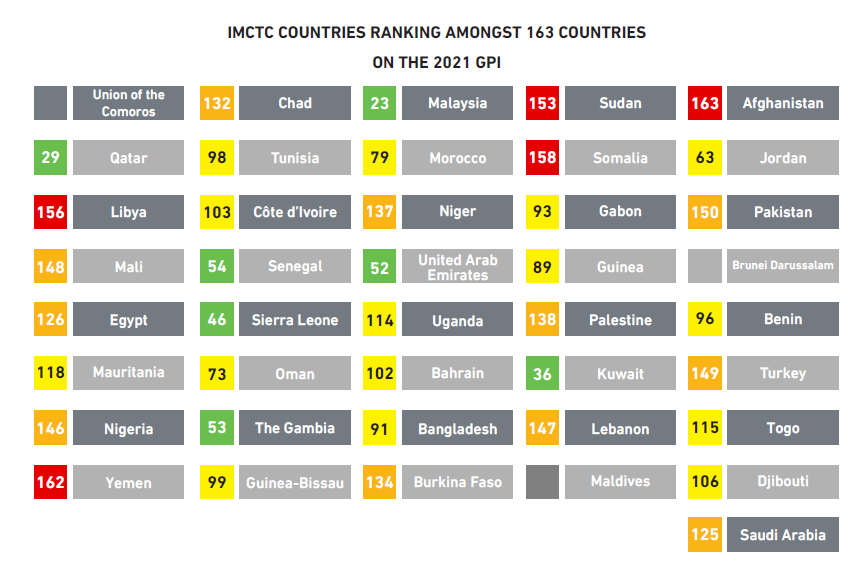
It is important to note that the aforementioned economic costs were calculated in local currency of the country under assessment and its equivalent in USD in terms of purchasing power parity (PPP).
Overall Results of Economic Impact of Violence
The results of the study of the economic impact of violence include the ten most affected countries and ten least affected countries, as well as the five big powers as follows:
First: most affected countries: Syria incurred losses equivalent to 82% of GDP, South Sudan 42%, Afghanistan 40%, the Central African Republic 37%, Somalia 25%, North Korea 27%, Columbia 27%, Yemen 23%, Libya 22%, and Cyprus 22%.
Second: least affected countries: Indonesia incurred losses equivalent to 2% of GDP, Bangladesh 3%, which is the same as Ireland, Malawi, Iceland, Papua New Guinea, Equatorial Guinea, Madagascar, Ghana, and Switzerland.
Results of Economic Impact of Violence on
IMCTC Countries
The following table shows the results of the study of the economic impact of violence on IMCTC countries, classified into groupings similar to the last classification:
1st grouping: states that incurred GDP losses of no more than 3%, marked by a dark green color.
2nd grouping: states that incurred GDP losses ranging between 3% – 5%, marked by a light green color.
3rd grouping: states that incurred GDP losses ranging between 5% – 8%, marked by a yellow color.
4th grouping: states that incurred GDP losses ranging between 8% – 15% marked by an orange color.
5th grouping: states that incurred GDP losses of more than 15%, marked by a red color.
- One IMCTC country of the 1st grouping, Bangladesh, incurred GDP losses of 3%.
- 10 IMCTC countries of the 2nd grouping incurred GDP losses ranging between 3% – 5%.
- 13 IMCTC countries of the 3rd grouping incurred GDP losses ranging between 5% – 8%.
- 6 IMCTC countries of the 4th grouping incurred GDP losses ranging between 8% – 15%.
- 8 IMCTC countries of the 5th grouping incurred GDP losses of more than 15%.
- In line with the GPI results, 3 IMCTC countries were not included rankings: Brunei Darussalam, Maldives Republic, and the Union of the Comoros.
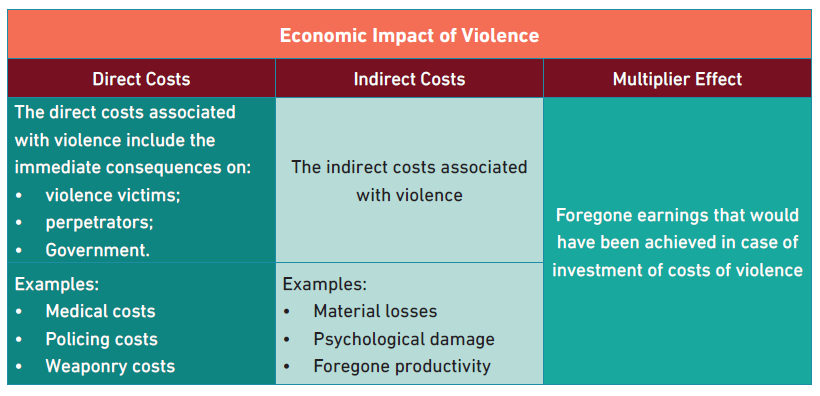
Positive and Negative Peace
2021 GPI introduced a vision for Positive and Negative Peace, their definitions, and pillars of Positive Peace, which are rather recommendations for countries seeking sustainable peace.
Negative Peace refers to the absence of direct violence or fear of violence amongst individuals, communities, and governments. This represents a negative perspective since it is only concerned with direct violence and only addresses current symptoms, turning a deaf ear to the pillars that would obviate countries of this violence and achieve sustainable peace.
Positive Peace refers to a set of pillars that eradicate the root causes of violence, achieve sustainable peace, and push countries to make conscious efforts to build a society bound by these pillars. These pillars are associated with fundamental issues, such as the achievement of development, ensuring suitable work environments, providing a better standard of living, and providing more flexibility addressing life issues. The following table provides definitions of Positive and Negative Peace established by GPI.
Positive Peace Pillars
The institutional perspective of Positive Peace is predicated on eight key factors, or Pillars, which are the properties of a state seeking to achieve Positive Peace. These properties are related to different issues, including a well-functioning government carrying out its mandated tasks, equitable distribution of resources and services, free flow of information, good relations with neighboring countries, focusing on human capital, acceptance of the rights of others, fighting corruption, and providing a sound business environment.
Positive Peace is predicated on eight key factors, or pillars, that describe the workings of the socio-economic system:
- WELL-FUNCTIONING GOVERNMENT: A well-functioning government delivers high-quality public and civil services, engenders trust and participation, demonstrates political stability and upholds the rule of law.
- EQUITABLE DISTRIBUTION OF RESOURCES: Peaceful countries tend to ensure equity in access to resources, such as education, health, and equity in income distribution.
- FREE FLOW OF INFORMATION: Free and independent media disseminates information in a way that leads to greater knowledge and helps individuals, businesses and civil society make better decisions. This leads to better outcomes and more rational responses in times of crisis.
- GOOD RELATIONS WITH NEIGHBOURS: Peaceful relations with other countries are as important as good relations between groups within a country. Countries with positive external relations are more peaceful and tend to be more politically stable, have better functioning governments.
- HIGH LEVELS OF HUMAN CAPITAL: A skilled human capital base reflects the extent to which societies educate citizens and promote the development of knowledge, thereby improving economic productivity, care for the young, political participation and social capital.
- ACCEPTANCE OF THE RIGHTS OF OTHERS: Peaceful countries often have formal laws that guarantee basic human rights and freedoms, equality between different races, religions, and social statuses, gender equality, and labor rights. Positive Peace is established by the acceptance of the rights of others.
- LOW LEVELS OF CORRUPTION: In societies with high levels of corruption, resources are inefficiently allocated, often leading to a lack of funding for essential services and civil unrest. Low corruption can enhance confidence and trust in institutions.
- SOUND BUSINESS ENVIRONMENT: The strength of economic conditions as well as the formal institutions that support the operation of the private sector. Business competitiveness and economic productivity are both associated with the most peaceful countries.
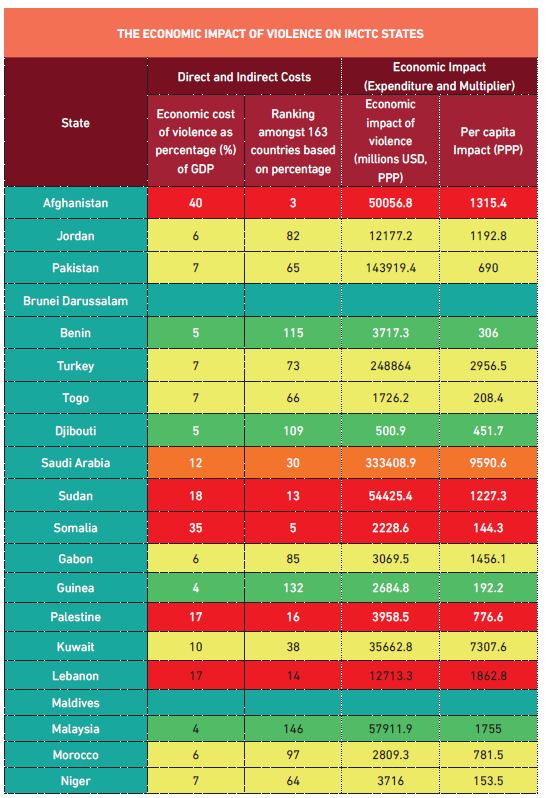
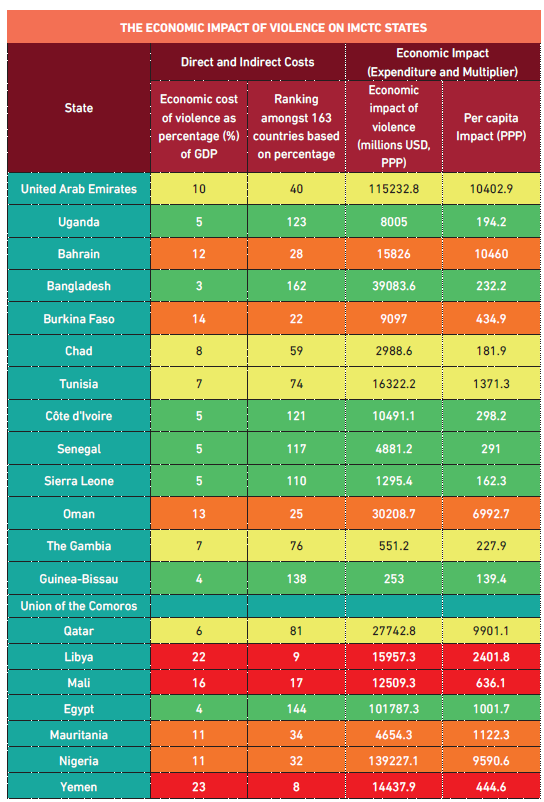
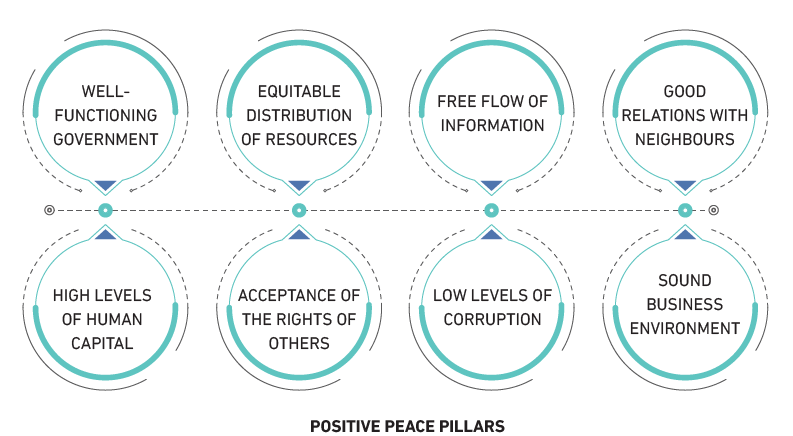
Executive SummaryThe 2021 GPI presents a vision of the level of peacefulness of 163 states, covering 99.7% of the world’s population. The GPI methodology uses three domains and 23 indicators to depict a comprehensive vision of global peace.
The 2021 GPI benefitted from previous GPI editions; comparisons were made to show the rise and fall of the GPI in every state, the development of peacefulness around the world, and to what extent the GPI deteriorated or improved.
Based on the results of the GPI, it conducted a study of the economic impact of acts of violence, and the potential benefits for individuals and society in case of investing such expenses in development projects.
The importance of the GPI and its results is manifested in the vision provided for decision makers, which can potentially contribute to Positive Peacemaking, eradicating violence at its roots, propelling development, and ensuring its sustainability.
However, there are yet other factors that can be added to the GPI, which can improve its structure and update its results, in order to assimilate the world’s variables and sudden changes as is the case of COVID-19 pandemic.